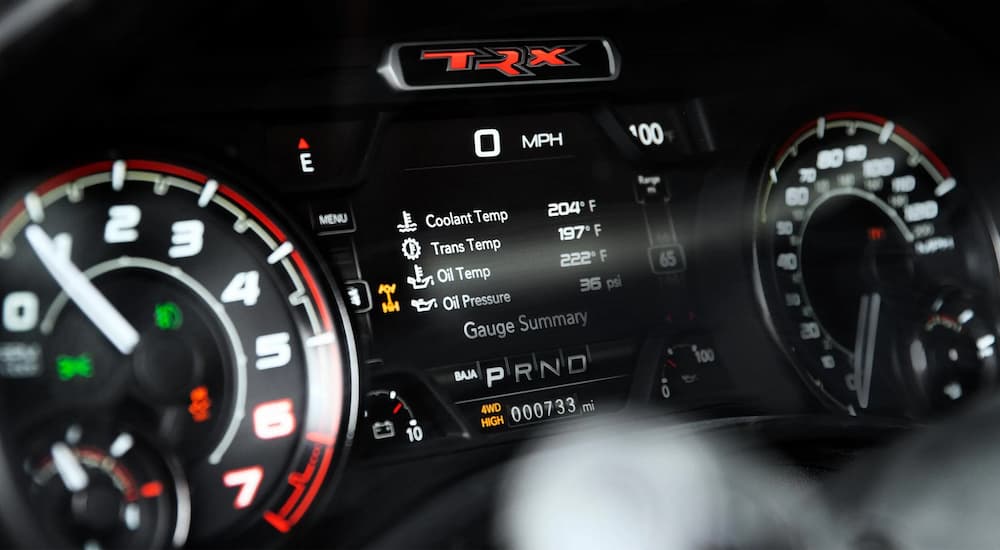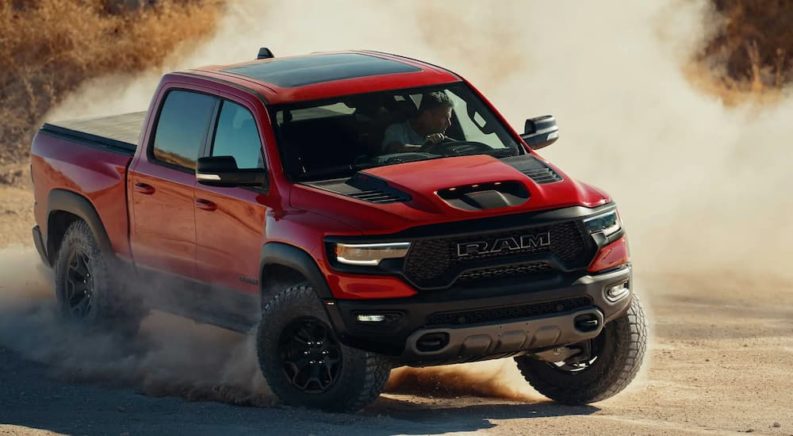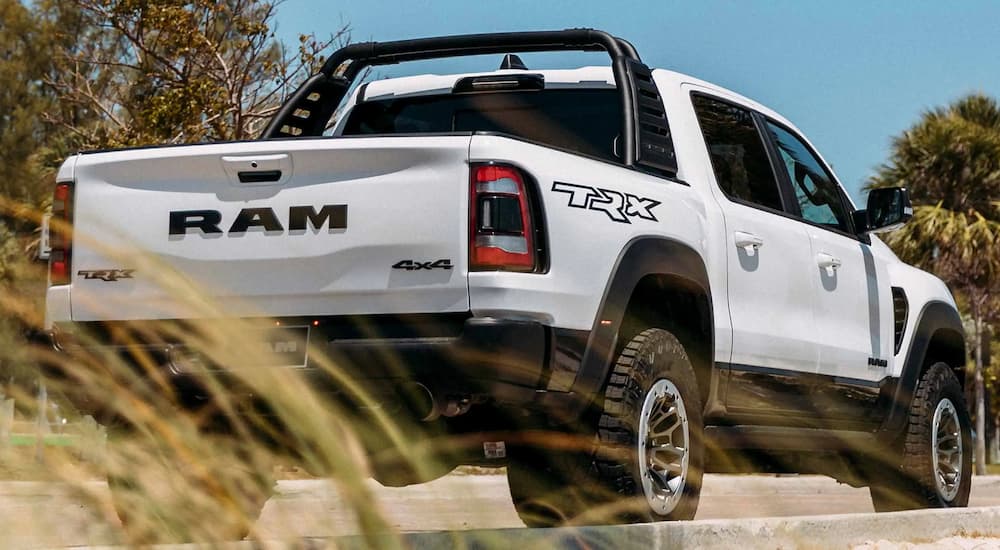702. Seven hundred and two. Thirty-five score and two or the square root of 492,804. No matter how you express it, it’s still a hardly believable number when talking about the horsepower of a mass-produced vehicle, but then, the Ram TRX is unlike any other vehicle on the market. Part of the new breed of high-performance super trucks, the 2022 Ram 1500 TRX is able to squeeze a record-setting number of horses out of its supercharged 6.2 HEMI V8, blurring the very concept of distinct vehicle categories with a 0-60 time that would put most sports cars to shame.
A figure that large is almost hard to appreciate, but let’s try to put it into context. The 702 horsepower super truck is equivalent to 2.3 Ford Explorers, almost five Ford Focuses, and 585 average humans (but only 200 Usain Bolts). Not helpful? Here’s another fun piece of context. The Dodge Charger SRT Hellcat, a true muscle car and nominally the fastest production vehicle in the brand’s lineup, only bests the TRX by a scant 95 horsepower. Even the most powerful Mack truck engines top out at 505 horsepower, giving Ram’s record-breaking super truck more oomph than the average 18-wheeler.
702 might seem like nothing when compared to, say, the horsepower of the of the world’s largest diesel engine (the 107,389 HP Wärtsilä RT-flex96C) or NASA’s STS-111 space shuttle main engine (a stratospheric 37,000,000 HP). However, it still earns its clear frontrunner status among modern super trucks, besting its closest competitor, the Ford Raptor, by more than 250 HP. The TRX was introduced as a direct challenger to Ford’s Raptor super truck, but they didn’t even bother to make it a fair fight. The TRX can go punch-for-punch with Ford’s own super truck, matching not only its rugged exterior but its luxuriously appointed interior as well. Under the hood, it’s not even a contest. The 2022 F-150 Raptor tops out at 450 horsepower, playing a clear second fiddle to Ram’s entry.
The 0-60 times are equally telling, with the TRX besting the Raptor by two whole seconds (3.7 to the Ram’s 5.7). We can get into the technical details as much as you like, but the truck’s names really tell drivers all they need to know: the Raptor’s power is nothing to scoff at, but it’s eclipsed by the tyrannical power of the TRX. Instead of wasting our time pretending these two trucks should even be in the same category, let’s look a little closer at the history of horsepower itself, how it evolved, and just exactly what 702 ponies means.

Ponies in the Past
So what is horsepower? Well, by definition, one mechanical horsepower lifts 550 pounds by 1 foot high in 1 second and is equivalent to 745.7 watts. There’s a much longer, more specific formula that more accurately describes the unit of measurement, but frankly, it makes our eyes hurt just looking at it with all its numbers, letters, and pi symbols. This technical definition isn’t terribly helpful, so let’s look at how we arrived at that formula as a way of better understanding the amount of power it expresses.
The term horsepower was first coined by Scottish engineer James Watt in the late 18th century (one guess as to the other notable unit of measurement Mr. Watt introduced to the world). Originally devised as a way to compare the output of steam engines to the draft horses that had long served as man’s primary means of conveyance, the term was, at its core, a marketing tactic. Watt was repairing an early version of the steam engine while working as an instrument maker at the University of Glasgow and quickly noticed a number of inefficiencies in the design. He set out to make his own version and introduced the Watt steam engine in 1776. The new-and-improved version was to be sold to farmers and miners, but this customer base had little context for what the engine’s output meant in real-world terms.
Watt set out to study ponies and working farm horses, calculating their carrying capacity as somewhere around 32,400 pound-feet per minute (for those who are curious, later studies have shown that the average horse can actually produce up to 14.9 horsepower over a short period.) With this number in hand, Watt devised the horsepower formula, which conveniently rated his steam engine at a nice, round 10 HP, and soon the metric took off. Farmers were better able to wrap their minds around the steam engine’s potential and soon saw the inherent benefit to a form of power that never needed a rest, a drink, or the occasional sugar cube. If anything, the metric actually undersells Watt’s invention, given that a horse could not operate at peak performance for nearly as long as the steam engine itself.
When talking about modern vehicles, there are a number of variations on the term horsepower you might run into. These include indicated (or gross) horsepower and brake horsepower. Indicated horsepower is usually what we think of when we first hear the term and is simply the engine’s theoretical horsepower potential in a frictionless environment. It’s a useful way to compare engines that might be called on to operate under extremely disparate conditions, but since the real world is lousy with friction, it’s not the best measure out there. Brake horsepower, a term often uttered by the well-paid baritones who narrate car commercials, is a much more useful measure as it takes into account the energy lost as a result of the friction engine components experience while in operation. Measured at the vehicle’s crankshaft, brake horsepower gets its name from the brake dynamometer used to test an engine’s actual output, providing a better indication of how much power it can actually produce in real-world conditions.
Horsepower has been on a steady rise since the term was first coined, with advances in engineering and automotive technology naturally producing more powerful engines. Introduced in 1908, the first Model T Ford had a measly 20 HP, and the figure continued to rise throughout the decades from an average of 70 HP in the 1930s to 220 in the mid-’60s before taking a massive dive in the ’70s due to the introduction of the Clean Air Act and the Oil Crisis of 1973. The numbers soon rebounded and have risen almost exponentially since. In fact, between 1980 and 2010, the average horsepower for passenger cars has increased by 80 percent to a current average of 240 HP.
702 Horses in Action
The sort of power produced by the TRX is a lot of fun to play around with, and drivers have been unable to resist doing just that. From tearing through the shadow of a dormant volcano to racing – and beating – a Dodge Challenger, the Ram TRX is here to show off. Unsurprisingly this has attracted the attention of the YouTube set, who rightly see the high-performance truck as a one-way ticket to viral stardom.
In one impressive – and costly – example, Youtuber Micheal Hyssong jumped the 6,386 pound 2021 TRX over a creek. While it left the truck damaged and netted Hyssong over $53,000 in environmental fines, it wasn’t enough to deter the creator from future escapades. Hyssong, who operates the channel Street Speed 717, enlisted the help of fellow YouTuber Vehicle Virgins for part two, in which the pair jumped the TRX over a rare Dodge Viper. If the $53,000 fine sounded costly, it’s a drop in the bucket compared to the price of the Dodge Viper Snakeskin ACR Edition, which sold for around $145,000 when it debuted in 2017. With only 31 examples of the striking green sports car on the market, the jump can be seen as somewhere between stunt and sacrilege. In the end, the jump was a success, with the pickup tapping every one of its 702 ponies to clear the viper and net Hyssong a couple hundred thousand views at the time of writing.
While there are more responsible ways to harness the unprecedented output of Ram’s class-defying super truck, that’s not really why these vehicles exist. Super trucks are designed for drivers who are looking to test the limits of performance, blaze a new path, or, sure, jump a creek (just don’t tell the EPA we said that). They blur the line between traditional categories, providing the beefy suspension of an off-road 4×4 with a powertrain that wouldn’t embarrass you at the drag strip. These are not your everyday vehicles, though the TRX goes a little off-script in this regard by providing a well-appointed cabin that’s hard to resist sliding into for a quick trip to the supermarket. With the TRX, Ram has set a new bar for just what a super truck can be, harnessing every one of those 702 horses for a ride you’ll never forget.





